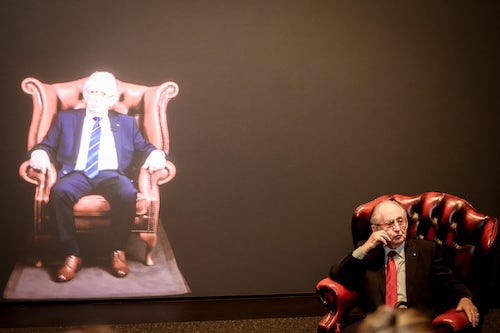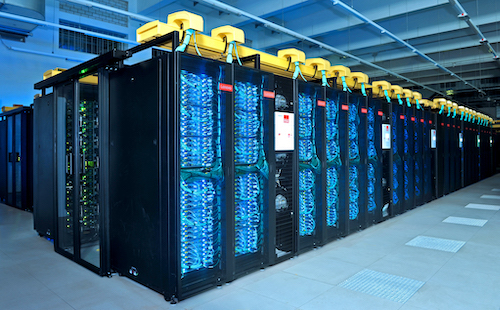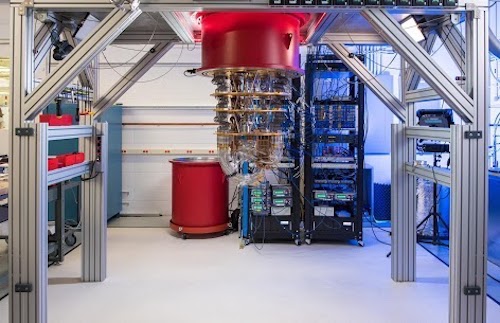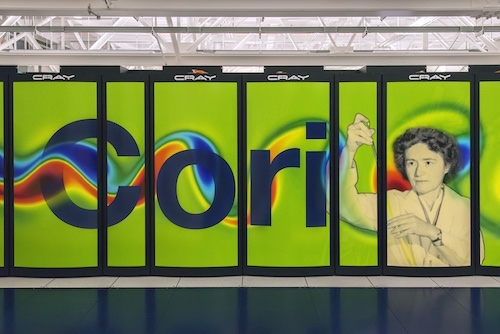LRZ-Newsletter Nr. 02/2020 of February, 6. 2020

Our Topics:
- News
- Workshops and Events
- Equipment to Give Away
- Job Opportunities
- More to Read
- Informations about the LRZ-Newsletter
- Imprint
News
Digital Contemporary Witnesses for the Classroomt

The old man sits in a red wing chair and tells: about escape, camp, family, survival. "What happened once can happen again. To avoid this, we have to talk about it," says Abba Naor, Holocaust survivor. That's why Naor and more contemprary witnesses now exists digitally: For the project Learning with digital certificates (LediZ), conversations with them were virtualized.
Important voices received
On January 22, 2020, LediZ presented the impressive contemporary testimonies at the Leibniz Supercomputing Centre (LRZ) in Garching to members of the Bavarian state government and scientists. Students expressed their impressions and the lessons they learned from the discussions with Naor and more witnesses: "We all know that we are losing more and more contemporary witnesses", Bernd Sibler, Minister for Science and Art, praised the work of Naor, the witnesses and the LediZ team in a video message. "That is why it is important to capture the voices with creative approaches and thus create documents that can be used in active teaching in the coming years".
LediZ is an interdisciplinary project in which didacticians, pedagogues, historians, linguists and social scientists as well as computer scientists and media specialists have been working together since 2018. The LRZ supported with technology. "We see the virtualisation of eyewitness reports as a great opportunity for the didactic mediation of material, because teachers and learners are dealing with the art of questioning, which is all too often neglected in learning", explains Anja Ballis, Professor of Didactics at the Ludwig-Maximilian-University Munich (LMU) and head of LediZ.
Researching Technology
Before being used in schools, the eyewitness reports are researched: in order to be able to compare the effect, the LediZ team visits school classes with Naor, after which his digital alter ego is used. With the LRZ, the LediZ team is also developing a package of mobile computer technology for demonstrating the virtual interviews in schools. And they are already thinking about other contemporary witnesses: for example, to personalise GDR history or to preserve the experiences of Roma and Sinti during the Nazi era: "A project," praised Minister Sibler, "in which one can see that technical and humanities are not opposites, but rather go well together. In this case, one serves the other, in the sense of historical memory work."vs
Get on the SuperMUC-NG

Teacher, doctor, educator, hairdresser, designer - when young women express their career aspirations, they think traditionally and limit their earning potential. In order to introduce schoolgirls to technical professions, companies, craft businesses and universities regularly invite them to Girls' Day. This year it will take place on 26 March. 12 schoolgirls from grade 8 on will visit than the Leibniz Supercomputing Centre (LRZ) for one day.
In addition to visiting the computer cube and the Visualization and Virtual Reality Centre V2C, they will also try things out: for example, photogrammmetry, the production of spatial images from photos, or three-dimensional drawing. Female staff members from different areas of the LRZ also describe their tasks. "The participants of the Girls' Day are always very enthusiastic", says Petra Gärtner, who coordinates the day. "We would like to show the variety of tasks for women at the LRZ, it would be nice if we could whet the appetite for an IT training with this action". The LRZ is currently looking for a trainee who wants to become an IT specialist. vs
Supercomputing for architects
 The Allianz
Arena has been proving its worth in all weathers for 15 years: its
outer wall is one of the largest membrane shells in the world. It is
just 0.2 millimeters thin and weighs a mere 350 grams per square meter:
"In recent years, lightweight materials based on membrane structures
have often been used to build stadiums with open and covered areas,"
says Michael Breuer, mechanical engineer and head of the Department of
Fluid Mechanics at Helmut Schmidt University in Hamburg. "Thin, light
structures, however, can easily be deformed or even destroyed by storm
or wind".
The Allianz
Arena has been proving its worth in all weathers for 15 years: its
outer wall is one of the largest membrane shells in the world. It is
just 0.2 millimeters thin and weighs a mere 350 grams per square meter:
"In recent years, lightweight materials based on membrane structures
have often been used to build stadiums with open and covered areas,"
says Michael Breuer, mechanical engineer and head of the Department of
Fluid Mechanics at Helmut Schmidt University in Hamburg. "Thin, light
structures, however, can easily be deformed or even destroyed by storm
or wind".
In order to increase the safety of such structures and open up more possibilities for architects, Breuer and his team are working on models and experiments to measure turbulence around a building. SuperMUC and its successor, SuperMUC-NG, are making themselves useful - they calculate the Hamburg research data.
New materials, new test methods
New materials and Computer Aided Design (CAD) have enriched architecture. With the help of models, designs can be tested in wind tunnels; high-performance computers enable high-fidelity simulations. In Hamburg they combine both - experiment and numerical simulation - to explore lightweight construction methods. Here, the engineer treats winds as "turbulent flows" or "fluid-structure interactions" (FSI). So far, these have been calculated with Large Eddy Simulations (LES), but these only take into account larger turbulences, making them coarse and imprecise. The computational challenge therefore lies in the multiphysical and multi-scale nature of the problem: researchers have to develop models for small and large turbulence, which also occur at different speeds.
Different tools combined
To get a grip on this complexity, the Hamburg research team developed a three-dimensional Computational Fluid Dynamics (CFD) simulation and coupled it with a finite element solver. They validated these tools on the basis of specific FSI data from laboratory experiments in wind and water tunnels. In this way, the effects of storms on structures can be measured more accurately. "We now have a better understanding of how materials and building structures are stressed. We can more easily decide how thick the membrane of a stadium roof, for example, needs to be," explains Breuer. "This ultimately leads to the design of safer buildings." Gusts are still an unsolved equation in the Hamburg simulation. To increase the resolution of their simulation and to be able to calculate small vortices in it, the team now needs the SuperMUC-NG: It offers many times the performance of its predecessor SuperMUC calculates more details. eg/vs
Faster Computing at SuperMUC-NG
The SuperMUC has been history since 2 January, and its successor, the SuperMUC-NG, has already warmed up and is well utilised. With its 311,040 computer nodes, it processes 26.7 quadrillion calculations per second and offers more than 700 terabytes of memory. To help scientists push Germany's currently fastest computer to its performance limits, the Leibniz Supercomputing Centre (LRZ) is organising the Extreme Scaling Workshop from 21 to 23 April 2020. Experts will show how to address computer nodes and eliminate bugs in applications. Interested parties can apply with a large scale project until the end of February. Gerald Mathias, habilitated physicist and member of the application support team of the LRZ, knows how supercomputers calculate even faster.
Why do supercomputer users need an Extreme Scaling Workshop?
Dr. Gerald Mathias: The users of the SuperMUC-NG are primarily scientists who develop applications for their research questions. They focus on simulations and data, not necessarily computer technology. However, their programs should use as many, preferably all nodes of the SuperMUC-NG as possible. The Extreme Scaling Workshop will therefore focus on how to optimize applications, make full use of the machine and thus speed up calculations. The workshop helps the participants to make the best use of the computing time they have been given, and helps us to make better use of the SuperMUC-NG and to get to know the applications that will be part of everyday life in a few years.
What are the main topics?
Dr. Mathias: On the one hand, existing programs are tested. Some errors or problems only become visible at extreme sizes, for example when applications require too much memory or communication between computer nodes takes too long. That costs computing time. The hunt for records also plays a role here, as does sounding out technology and science at a high level. For example, when optimized programs simulate even larger and better models of the origin of the universe, this pleases the researcher and us as well. It's all about the future viability of simulations. What is still possible today on supercomputers will be commonplace on the next generation of computers. In normal operation such optimizations are hardly possible, hence the Extreme Scaling Workshop. For debugging and optimization you have to start and evaluate many jobs, you would be busy with this for months in normal operation, in the workshop the most important optimizations can be done in three days - and the participants can access the help of the experts from Intel, Lenovo and the LRZ.
The workshop is designed for the SuperMUC-NG - can I work better with other supercomputers afterwards?
Dr. Mathias: The architecture of the supercomputers is very similar, they all consist of many computer nodes and a fast network. Even if they differ in their structure - optimization, debugging, communication between the nodes, the use of memory - all other computers are also affected. In this sense, the Extreme Scaling Workshop generally helps with High Performance Computing.
Participants should apply with a Large Scaling project: According to which criteria do you choose?
Dr. Gerald Mathias: The interest in the workshop is high, we can consider a maximum of eight projects, often there are teams behind them. Participants need experience in working with supercomputers. In addition, the computing power and the amount of data to be processed, i.e. the research project should be challenging, groundbreaking and innovative. And of course the SuperMUC-NG should be used to its fullest possible capacity with the projects. We already have some requests, the application deadline is the end of February. vs

Future Sounds of Quantum
They should be able to calculate faster and process larger amounts of data: The race for the first operational quantum computers and for proving the superiority of this technology is gaining momentum. This was evident in January at the fifth meeting of the Bavarian Quantum Computing eXchange network (BQCX). Every second Wednesday of every month, representatives from science and industry meet at the Leibniz Supercomputing Center (LRZ) in Garching. In January, Google as well as the startups IQM and Quantum Brilliance presented solutions for the stabilization of qubits, the construction of processors and hardware.
Quantum computers calculate differently, they use the physical properties of the smallest particles. These are extremely sensitive, so that qubits can only be achieved and maintained with the greatest effort. For this reason, the Australian start-up is relying on diamonds to build up qubits and thus processors.
Thinking out Loud

Quantum computers do not process computing tasks in individual steps, but simultaneously. With its Sycamore, Google wants to have developed the first processor that works with 54 qubits and calculates a probability calculation in minutes, for which supercomputers need thousands of years. The 53 qubits that actually handled the calculation of random numbers, if they were connected differently at Sycamore, still produced the same results.
Next generation computers require new technology: IQM is one of those companies that takes care of hardware. The Finnish start-up's systems promise higher clock frequencies for future quantum computers. Like Quantum Brilliance, IQM relies on partnerships from supercomputing to further develop its technology. Quantum technology still asks many questions. Although research, industry and even politics are thinking aloud about the next generation of computers, it will take time before these voices become a real work or product. More about the meeting you will read on our website. vs
Figures of the month
Quick, quick, quickest: The Leibniz Supercomputing Centre (LRZ) has now succeeded for the first time in transferring an average of 4.5 gigabytes (GB) of data per second over 9000 kilometres. "Three ingredients make this speed possible," explains Stephan Peinkofer, Lead Architect for Storage Infrastructures at the LRZ. "Firstly, our powerful Data Science Storage System (DSS), then the hybrid transfer service Globus Online and finally a comparably powerful infrastructure on the counter or addressee side".

4.5 GB corresponds roughly to the data of a movie or the content of a DVD. In supercomputing, however, this is a cinch. The amount of data that astrophysicists from Potsdam wanted to send via the LRZ in Garching to colleagues in Berkeley to the high-performance computing centre NERSC, the National Energy Research Scientific Computing Centre, was about a hundred times as large, i.e. about 500,000 gigabytes or half a petabyte. They were transferred in individual packages over several weeks: thanks to the DSS from LRZ and Globus Online as easy as a text or image with LRZ Sync & Share.
For this purpose, the DSS is based on two IBM Spectrum Scale Clusters, two Globus Connect Servers and a high-speed Ethernet network for the management of files. The fast transfer via internet between the Globus Connect servers of source and destination is controlled and monitored by Globus Online, a non-profit internet service of the University of Chicago and the Argonne National Lab of the USA for science, which is also provided by the LRZ to its users for the DSS. Because the NERSC in Berkeley works with similar equipment, the data quickly flows across continents via nodes and lines. "With different architecture and software," says Peinkofer, "it gets more complicated and therefore also significantly slower or more expensive." vs
Workshops and Events
Test DEEP-EST
DEEP-EST abbreviates Dynamical Exascale Entry Platform - Extreme Scale Technology and is a project funded by the European Union: It's goal is to develop a modular supercomputing architecture. Its elements - tools, software, applications - should now prove themselves in everyday life. Scientists and users from industry, who are experienced in HPC, with the development of artificial intelligence and systems for machine learning, will find tools and technology that will help to improve and facilitate their work. These can be used, assessed and evaluated. Users are therefore asked for their written assessment. There are two different types of applications for testing and trying out: With the Single Call Type2 all HPC applications can be tested. Registration ends on February 28, 2020. With the Open Call Type1 interested parties register the use and evaluation of special applications, which ends on September 15, 2020. More information on the accesses is available online.
Programming with OpenMP
OpenMP is the programming language for parallel computer systems and enables supercomputing to build specific applications for a wide range of research questions. Lecturers from various universities as well as from INTEL will introduce participants of this three-day PRACE workshop from 11 to 13 February 2020 at the Leibniz Computing Centre to this powerful programming language and show the tricks with which it helps even advanced users to solve data problems.
Programming with Fortran
Programmieren lernen mit Fortran – drei Tage können sich Studierende diesem Thema am LRZ widmen: Vom 26. bis 28. Februar 2020 führen Dr. Reinhold Bader und Dr. Nisarg Patel in die Vor- und Nachteile der Programmiersprache ein und zeigen, wie Wissenschaftler damit eigene Anwendungen entwickeln können. Voraussetzung sind Basis-Kenntnisse im Umgang mit UNIX und Linux.
Working with ANSYS
ANSYS is a package of more than 20 applications for engineers and scientists. At the Leibniz Computing Centre, CFX and Fluent in particular are used very often to display and calculate flow properties of liquids or gases. A five-day workshop from 16 to 20 March will therefore focus on these programs and their use in a Linux cluster. Dr. Barbara Neuhierl from CADFEM, an IT service provider from Grafing, and Thomas Frank from the LRZ will explain to students, lecturers and interested parties how they can work with ANSYS and solve their own research questions.
Semantic Patching with Coccinelle
Coccinelle is a valuable tool to check programming in C code or to find and eliminate bugs and errors. On a training day on March 24, 2020, participants will learn how to use Coccinelle, how to identify patterns that indicate errors and how to extract all the benefits from the program for efficient, well-performing code. The last available places will be allocated as a result of the registrations.
Security Day 2020
Data mishaps of companies, where customer data is lost or becomes public, have become part of everyday life. But what can users learn from this for their daily work on the Internet? This is one of the questions that will be discussed during the Security Day 2020 at the Garching Research Campus on 26 March 2020. Natalie Vogel and Eda Seval, who coordinated the certification of the LRZ, show that the standardization of processes also serves security and data protection. Other presentations will deal with the quality and sensitivity of data and the measures that users themselves can take to protect their privacy. The Security Day is organized by the Leibniz Supercomputing Centre in cooperation with the Munich universities and the Gesellschaft für Datenschutz und Datensicherheit (GDD). Participants of the Munich scientific network, the members of the GDD-ERFA-Kreis Bayern and other interested parties are invited. Participation is free of charge, no prior technical knowledge is required, but registration is necessary.
Data Protection Day 2020
The data protection laws in Europe and Germany, which have been in force since 2018, not only sensitize companies and consumers to the importance of data, they also attract a lot of international attention. But how do companies implement data protection in their processes in practice? At the Data Protection Day at the Garching Research Campus on 27 March 2020 at the Leibniz Supercomputing Centre (LRZ), practitioners and lawyers will provide information. Stefan Metzger, Natalie Vogel and Eda Seval from the LRZ will show that the combined certification of the LRZ according to ISO/IEC 20000 and 27001 also has advantages for data protection.. Brigitte Frey, Data Protection Commissioner of the City of Munich, reports how the Bavarian metropolis implements data protection in its departments and what experiences employees have with it. The Data Protection Day is organized by the Leibniz Suopercomputing Centre, the Munich universities and the Gesellschaft für Datenschutz und Datensicherheit (GDD) and is aimed at data protection officers and interested parties with previous legal knowledge. Participation is free of charge, registration is requested.
Girl's Day
To interest young women in technology and tasks related to information technology, digitisation and computing is the aim of the supra-regional Girl's Day on 26 March 2020, which will also be attended by a group of schoolgirls from the eighth grade onwards at the Leibniz Supercomputing Centre (LRZ). More information about Girl's Day in the article above and on the Internet.
Better Computing with SuperMUC-NG
Demanding the new SuperMUC-NG and exhausting its computing power: This is the focus of the Extreme Scaling Workshop from 21 to 23 April 2020, where scientists can apply for the three-day course with their large-scale projects until 21 February. Specialists from the LRZ as well as Intel and Lenovo will demonstrate how the multicore machine works faster and more efficiently and is optimally utilized.
Standards for Interfaces
The eighth international workshop around the interfaces OpenCL, SYCL, Vulkan and Spir-V, called IWOCL, will take place from April 27th to 29th at the Leibniz Supercomputing Centre (LRZ) in Garching, Germany, where the interfaces accelerate and optimize the integration of applications on GPU or accelerators. They will be important for the development of the next generation of high performance computers. Computer specialists and engineers discuss solutions for standardization during the workshop.
Equipment to Give Away
The LRZ separates from used printers. Students, lecturers or employees of the universities and authorities report their interest by November 25, 2020 at the following e-mail address <althardware@lrz.de>. We will be happy to contact you.
Equipment to give away:
- 2 printers Xerox Phaser 7400 und 5500 DTM, year of construction 2006
- 1 printerXWorkCentre 4250 VSM, year of construction 2011
- 44 desktops Optiplex, 2 bis 16 GB, years of construction 2006 to 20011
- 2 desktops Precision T1700//1500, year of construction 2010 and 2013
- 21 laptops Latitude, diverse types and storage capacities, years of construction 2007 to 2011
- 1 laptop Lifebook P7010, Centrino
Job Opportunities
The following positions are currently open at the LRZ. You will find
a diverse, international team in Garching. Most job offers are in
German – for questions you will find English speaking colleagues here.
Don't hesitate to e-mail or phone and send your unsolicited
applications. Please visit our website, if
you search for other job opportunities.
- Training position IT Specialist System Integration
- Student Assistant for Web, JavaScript, TypeScript
- Student Assistant for the license team
- Student Assistant for the service desk
More to Read
Here you will find links to the latest information from the German and European supercomputing community and our cooperation partners:
- Publications of the Gauss Centre for Supercomputing (GCS): GCSNews and Inside
- Infoletters of the Gauß-Allianz: PDF: 2 pages
- PRACE: Newsletter
Informations about the LRZ-Newsletter
- The LRZ Newsletter is published in German and English. You can find the latest and former editions on the LRZ-Website.
- You have problems displaying the newsletter? Please send a short description of your problem to <NewsletterRedaktion_AT_lrz.de>. Thank You!
- You can subscribe or unsubscribe the LRZ-Newsletter via ourwebsite.
Imprint
- Herausgeber:
- Leibniz-Supercomputing Centre of the Bavarian Academy of Science and Humanties
- Boltzmannstraße 1
D-85748 Garching - Phone:
- +49-89-35831-8000
- Telefax:
- +49-89-35831-9700
- E-Mail:
- lrzpost_AT_lrz.de
- Editorial Office:
- PR Team
- Photos, Graphics:
- Adobe, Allianz Arena/B. Ducke, Google, A. Podo/LRZ, NERSC
